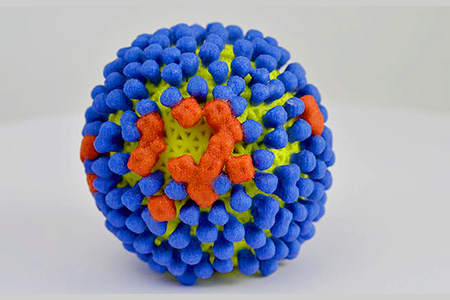Aging and Immunology
 Aging has dramatic effects on many body systems; almost every aspect of immune response is changed with aging including adaptive immune cells (T & B), spleen and lymph node micro-architecture, skin, gut microbiome and the respiratory system. Dr. Haynes' presentation focused on the response of lung epithelial cells to flu infection and how age results in significantly reduced immune responses, with lower antibody titers and affinity.
Aging has dramatic effects on many body systems; almost every aspect of immune response is changed with aging including adaptive immune cells (T & B), spleen and lymph node micro-architecture, skin, gut microbiome and the respiratory system. Dr. Haynes' presentation focused on the response of lung epithelial cells to flu infection and how age results in significantly reduced immune responses, with lower antibody titers and affinity. Data from the Centers for Disease Control and Prevention shows that people age 75 and above make up 77% of those who die from Influenza infections. Clearly, the flu impacts the elderly in ways that younger people can combat.
Influenza replicates only in the lungs. It cannot replicate in any other tissue. But, as noted above, symptoms of the flu are systemic. This is one of the mysteries that Dr. Haynes' lab is trying to solve.
Influenza Mouse Model
Dr. Haynes' lab currently utilizes C57BL/6 strain of mice from 2 different age groups: 3-6 months which is equivalent to a human adult aged 20-30 years and 18-24 months which is equivalent to a human adult aged 56 - 69 years. Mice are administered sub-lethal doses of an H1N1 Influenza strain and tissues harvested at various time points. Lung tissue is harvested for PCR to examine total viral load, while bronchiolar lavage fluid is measured for cytokines and to examine what cells infiltrate the lungs during infection. Spleen and draining lymph nodes are also examined for immune response cells.Study Results
The lab is finding that young mice clear infection faster than older mice and young mice regain weight loss faster than older mice after the initial infection. Flu-specific IgG rises rapidly in young mice and is present for 3 weeks. Older mice do not mount a strong response. Overall, younger mice have a better immune response to the influenza challenge.Additionally the appearance of influenza nuclear protein-specific CD4 cells and IL-10 in lung airways is delayed in aged mice during the infection. As measured by the presence of albumin, they see more damage in the lungs of aged mice.
Influenza infection also leads to decline in muscle integrity and function and is especially detrimental to older people. When examining the gastrocnemius muscle in their mouse model, no flu virus can be found. Mediators of inflammation, such as IL6ra, Cxcl10 and TNF increase in muscle during influenza infection in older mice. Atrophy gene expression goes up during flu infection and it takes longer to return to baseline in older mice. Myogenic gene expression (Igf1, Myod1, Mef2c, Myf5, MyoG and Pax7) that induce muscle differentiation are decreased during infection and take longer to go back up in the older mice.
So What does this Mean?
Pneumonia and Influenza are the number 3 leading cause of catastrophic disability in the elderly as defined as a loss of independence. Older people who get the flu frequently end up in the hospital. Hospitalization of elderly people has a huge impact on health often resulting in a further decline in health. Dr. Haynes' research results from mouse models are helping to elucidate the differences in how the response to influenza infection is affected by age.If Dr. Haynes' lab can identify the factor or factors that affect muscle loss during flu, they may be able to block them and prevent muscle loss, effectively helping elderly people better weather flu infections.
















.jpg)

.jpg)
.jpg)
.jpg)
.jpg)





.jpg)


.jpg)
.jpg)




.jpg)




.jpg)

.jpg)



